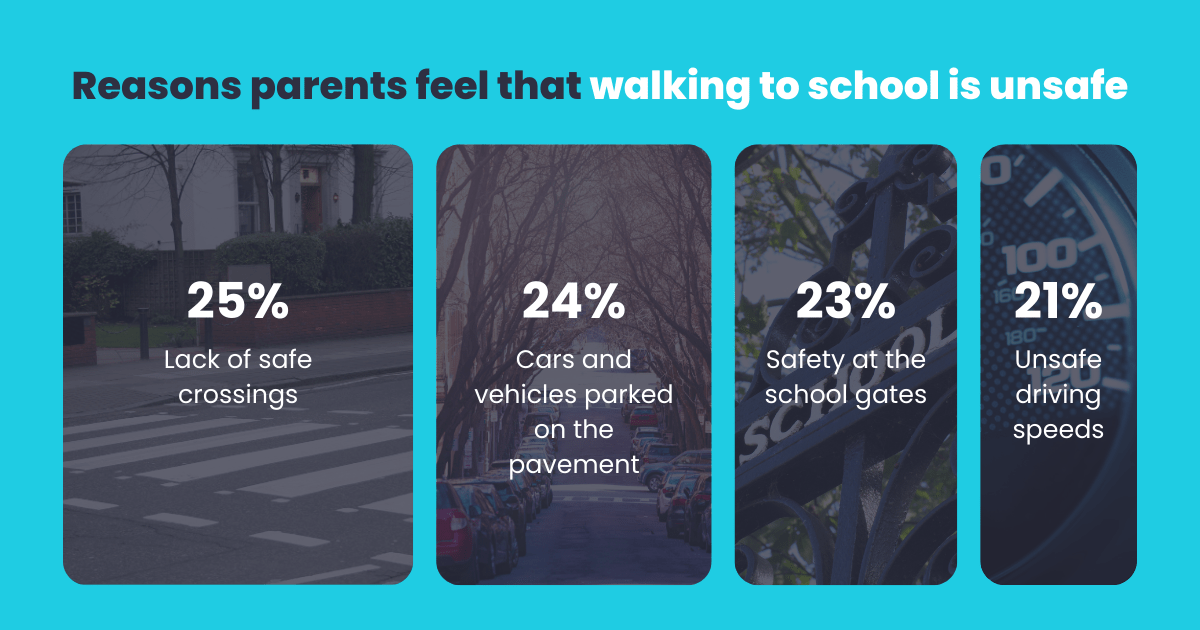
Driving Test Booking Changes For 2025 and 2026
Your guide to the latest driving test booking changes, new DVSA rules and measures aimed at cutting waiting times for learner drivers across the UK.
Driving near schools is a significant responsibility, requiring heightened awareness and extra caution, particularly during peak times when children are arriving at or leaving school. In the UK, traffic regulations are specifically designed to protect the most vulnerable road users; children, who may not fully understand the dangers associated with traffic. For learner drivers, developing the skills necessary to navigate these busy areas is crucial not only for passing their driving test but also for ensuring the safety of all road users.
Navigating school zones involves more than just following the speed limit; it requires an understanding of the unique challenges these environments present. Whether you’re a learner driver trying to build confidence or an experienced motorist looking to refresh your knowledge, this guide will provide you with essential tips and information. By staying informed and vigilant, you can help reduce the risks associated with driving near schools and contribute to a safer road environment for everyone.
School zones are often bustling with activity, particularly during the early morning and mid-afternoon hours. Parents dropping off or picking up their children, school buses arriving and departing, and children walking or cycling to and from school, all contribute to a busy and potentially hazardous environment. For this reason, UK traffic regulations impose specific rules and speed limits around schools to enhance safety.

Source: https://www.livingstreets.org.uk/press-media/dangerous-driving-stops-families-walking-to-school-suggests-new-data/
Understanding these regulations is essential, as they are in place not just to protect pedestrians but to guide drivers in navigating these complex areas. For instance, reduced speed limits in school zones are strictly enforced, and failure to comply can result in severe penalties. Furthermore, special attention must be paid to pedestrian crossings, where children may suddenly appear from between parked cars or other obstructions.
It’s not just about following the law; safe driving near schools is about recognising the unique risks and taking proactive steps to implement them. This means staying alert, anticipating potential hazards, and reacting calmly and appropriately. Whether you’re a learner driver getting to grips with the basics or a seasoned driver familiar with the roads, understanding the importance of these regulations and best practices is key to ensuring everyone’s safety.

Driving safely near schools is not just about adhering to legal requirements, it’s also about ensuring the safety of children on their way to or from school. Here are five reasons why extra caution is necessary when driving in school zones:
High Pedestrian Activity: Schools are often surrounded by children who may not fully grasp the dangers of the road. Their unpredictable behaviour, such as running or crossing without looking, makes it imperative for drivers to stay alert.
Reduced Speed Limits: In the UK, speed limits in school zones are typically reduced to 20 mph. These limits are designed to minimise the risk of accidents and to ensure that drivers have enough time to react to sudden movements.
Increased Vulnerability of Children: Children are more susceptible to serious injuries in road accidents due to their smaller size and developing physical abilities. Even a minor collision can have severe consequences, making it crucial to drive cautiously.
Congested Roads During Peak Times: The roads around schools can become highly congested during school drop-off and pick-up times. This congestion can lead to impatient driving, increased risks of accidents, and the potential for failing to spot pedestrians.
Legal Consequences: Failing to comply with school zone regulations can result in significant penalties, including fines, penalty points on your driving licence, or even a driving ban. The legal implications underscore the importance of adhering to these safety measures.
To ensure pedestrian safety and to comply with driving regulations near schools, here are five essential safety tips:
Always adhere to the reduced speed limits in school zones, which are usually 20 mph in the UK. Speed limits are strictly enforced in these areas to protect children and other vulnerable road users. Additionally, be vigilant for road signs that indicate the presence of a school, pedestrian crossings, and parking restrictions. These signs are designed to guide drivers safely through potentially hazardous areas.
Pedestrian crossings near schools are heavily used, especially during the start and end of the school day. Slow down as you approach crossings and be prepared to stop even if no pedestrians are immediately visible. Children may suddenly appear from between parked cars or other obstacles. Additionally, always give way to pedestrians waiting to cross or already crossing the road.
Distractions, such as mobile phones, eating, or adjusting the radio, can significantly impair your ability to react quickly to unexpected situations. When driving near schools, it’s crucial to remain focused on the road. Even a momentary lapse in concentration could lead to dangerous consequences, particularly in an environment where children may behave unpredictably.
School patrol officers, commonly known as lollipop men and women in the UK, play a vital role in helping children cross the road safely. These officers are trained to manage traffic and ensure that children can cross the road without risk. Always stop when instructed by a patrol officer, and never attempt to overtake other vehicles near a school crossing. Patience and compliance in these situations are essential for maintaining safety.
When driving near schools, it’s important to anticipate potential hazards and react calmly. Children may dart out into the road unexpectedly, and other drivers may stop suddenly to drop off passengers. Keep a safe distance from the vehicle in front of you and avoid aggressive driving behaviours such as tailgating or honking. By maintaining a cautious approach, you can reduce the likelihood of accidents and ensure that everyone remains safe.
Driving near schools requires more than just the basic skills of operating a vehicle; it demands heightened vigilance, a thorough understanding of traffic regulations, and a commitment to protecting the most vulnerable members of our community. By adhering to the safety tips and legal requirements outlined in this blog, you can make a significant difference in ensuring the safety of children, parents, and fellow road users in school zones.
As a driver, whether you’re still learning or have years of experience, your actions behind the wheel have a direct impact on the safety of others. The extra caution you take in school zones not only helps to prevent accidents but also sets a positive example for other drivers, particularly those who are still developing their driving skills.
In summary, safe driving near schools is a responsibility that everyone must take seriously. By following the guidelines and remaining alert to the unique challenges these environments present, you can help create a safer road environment for everyone. Remember, the safety of our children and communities depends on our collective commitment to driving responsibly.
Commonly asked questions about driving near schools
If you encounter heavy traffic near a school, it’s important to remain patient and avoid aggressive driving behaviours. Allow extra time for your journey, maintain a safe following distance, and be prepared for sudden stops. Consider alternative routes, if possible, but always prioritise safety over speed.
If a child suddenly steps onto the road, immediately reduce your speed and be prepared to stop. Avoid swerving, as this could cause a collision with oncoming traffic or pedestrians. Always remain calm and alert, particularly in areas where children are likely to be present.
Yes, during school drop-off and pick-up times, traffic can become highly congested. Drivers should be extra cautious, avoid stopping in no-parking zones, and be mindful of children crossing the road. Patience and adherence to all posted signs are crucial during these busy periods.
Overtaking a stationary vehicle near a school is risky, especially if it’s unclear why the vehicle has stopped. It could be waiting for a pedestrian to cross, and overtaking might endanger them. Always exercise caution and avoid overtaking unless you have a clear view of the road ahead and are certain it’s safe to proceed.
Speeding in a school zone can result in severe penalties, including fines, penalty points on your driving licence, and even disqualification from driving. More importantly, speeding endangers the lives of children and other pedestrians. Always adhere to the speed limits and drive with caution near schools.
You will be logged out in seconds. Do you want to stay signed in?